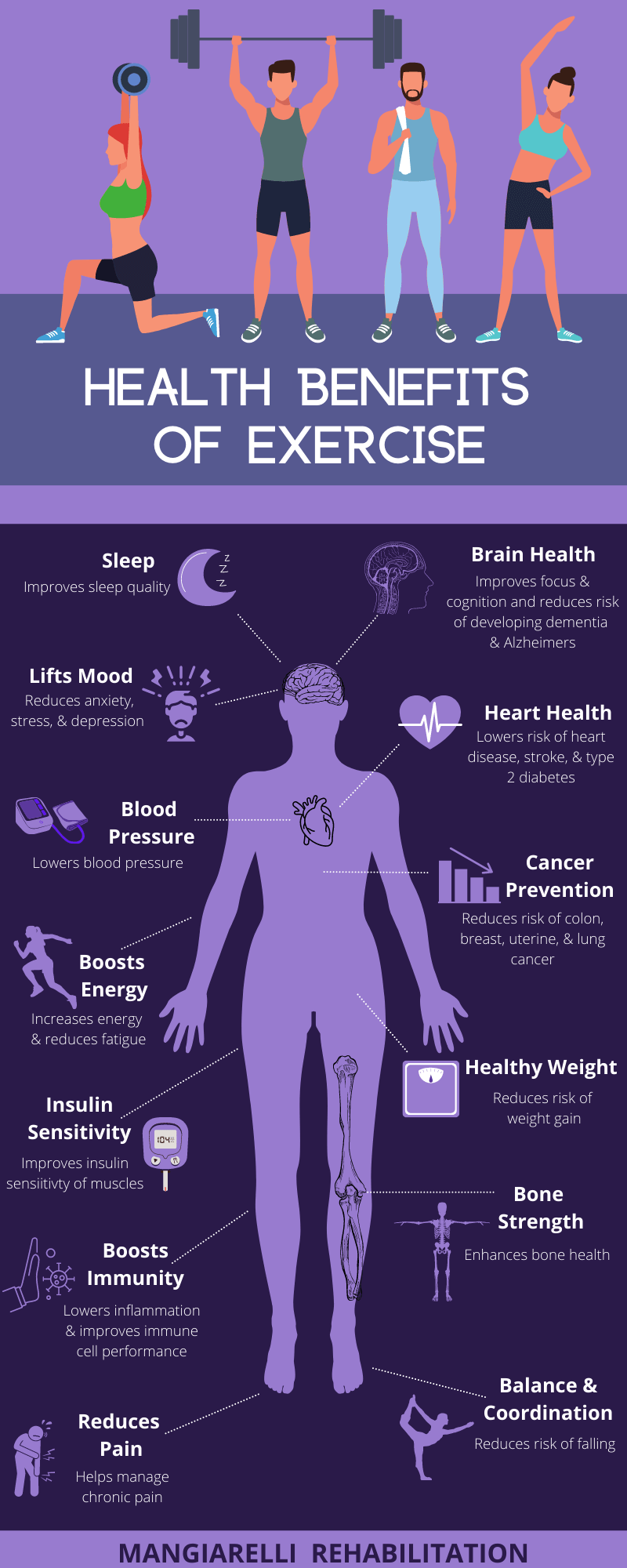Health Benefits of Exercise Infographic
Exercise is a critical component of a healthy lifestyle. Consistent exercise not only can prevent diseases like diabetes or cardiovascular disease but can also help you manage these chronic conditions and maintain function, endurance, and mobility. It is recommended to engage in at least 150 minutes of aerobic exercise each week, or 30 minutes a day, and strength train at least two times per week. While aerobic exercise and strength training are essential, be sure to incorporate balance and flexibility exercises as well.
Aerobic exercise involves physical activity that increases your breathing and heart rate and improves your cardiovascular endurance. Aerobic exercise improves the health of your heart, lungs, and circulatory system and can involve brisk walking or jogging, yard work, dancing, biking, swimming, or playing sports like tennis or basketball.
Strength training involves using weights, resistance bands, weight machines, or bodyweight training to increase your muscle mass. Strong muscles help to keep you independent and prevent falls. Lower-body strength training can improve your balance and improve your overall stability in combination with core strengthening. You should strength train your major muscle groups at least twice a week but avoid working the same muscle group two days in a row. Regular stretching improves your flexibility and is important to perform after aerobic exercise or strength training.
Exercising outdoors in nature has countless benefits for both your physical and mental health, improving mood, enhancing relaxation, reducing anxiety and stress, and increasing Vitamin D through exposure to sunshine.
Here are 15 health benefits of exercise:
Brain Health: Exercise stimulates the body to release proteins and other chemicals that improve the structure and function of the brain and enhance the growth of brain cells. Exercise can sharpen your thinking, learning, and judgment skills and enhance your focus and cognitive skills. Exercise can also reduce the risk of developing dementia and Alzheimer’s disease. One study in older adults showed that exercise can impact and grow the hippocampus, which is important for memory and learning. Exercise also helps improve the health and function of synapses between neurons in the brain, allowing brain cells to better communicate.
Heart Health: Exercise lowers the risk of cardiovascular-related diseases such as heart disease and stroke. Exercise strengthens the heart, improves circulation, and increases blood flow with raises oxygen levels in the body. This helps your cardiovascular system function more efficiently.
Cancer Prevention: Exercise can reduce the risk of colon, breast, uterine, and lung cancer.
Healthy Weight: Exercise helps you maintain a healthy weight and prevent obesity which can contribute to chronic disease.
Bone Strength: Exercise enhances bone health and builds stronger bones. As we age, we lose bone density, particularly in post-menopausal women. Targeted strength training can counteract this loss and restore bone density. Exercise also lubricates joints and can reduce chronic joint inflammation such as osteoarthritis.
Balance & Coordination: Exercise can reduce the risk of falling. Strong bones and muscles can help you improve your balance and coordination even as you navigate uneven terrain.
Sleep: Exercise can improve your sleep as the energy depletion that occurs when physically active stimulates recuperative processes during sleep. If you exercise outdoors, the vitamin D from the sun can also help regulate your wake-sleep cycle.
Lifts Mood: Exercise can reduce anxiety, stress, and depression. While exercising, exercise releases endorphins which help to reduce pain and boost pleasure, giving a general feeling of well-being. Research has shown that exercise is effective for mild or moderate cases of depression. Exercise increases concentrations of norepinephrine (a chemical in your brain that helps moderate the brain’s response to stress), which eases feelings of depression and anxiety.
Blood Pressure: Exercise lowers your blood pressure by improving your heart’s capacity to pump blood and opening up blood vessels throughout the body, making them better at moving blood throughout the body and lowering your blood pressure.
Boosts Energy: Exercise increases energy and reduces fatigue. Exercise brings oxygen and nutrients to your tissues and helps your cardiovascular system work more efficiently, boosting energy. One study found that 90% of people who completed a regular exercise program reported improved fatigue and more energy than those who did not exercise.
Insulin Sensitivity: Exercise helps you manage your blood sugar and insulin levels. It also cuts the risk of developing metabolic syndrome and type 2 diabetes significantly. Exercise lowers blood sugar by increasing the insulin sensitivity of the body’s cells; as muscles contract, they are better able to use any available insulin to take up glucose for energy.
Boosts Immunity: Exercise lowers inflammation which enables better immune function and can improve immune cell performance. A 2018 study linked moderate exercise with a lower incidence of acute respiratory illness and fewer sick days off of work.
Reduces Pain: Exercise can help you reduce and manage chronic pain. Research shows that exercise can help control pain that is associated with chronic back pain and arthritis. Regular physical activity can raise your pain tolerance and decrease your perception of pain by training your body to safely engage in movement without aggravating your chronic pain.
Sexual Health: Exercise can improve your sexual health, lowering the risk of erectile dysfunction in men and in those with the condition, helping to improve sexual function. In women, exercise can also increase sexual arousal.
Skin Health: Regular exercise can increase antioxidants in your body, which help protect cells from oxidative stress and free radicals which can damage your skin. Exercise also promotes blood flow which can give a post-exercise glow to your skin.
